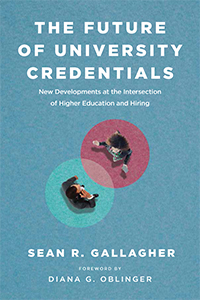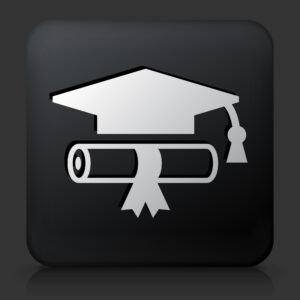
In 2015, a branch of the professional services firm Ernst & Young announced it was scrapping traditional academic credentials as a qualification for potential employees. Instead, the company would assess applicants’ skills via online testing.
Was this the beginning of the end for the academic degree as we know it? Will degrees become irrelevant in a rapidly changing job market that cares more about competencies than credentials?
In The Future of University Credentials (Harvard Education Press), Sean R. Gallagher’s answer is no. But it’s a qualified no. Gallagher’s carefully researched book concludes that traditional academic credentials occupy a special place in the job market and will not disappear anytime soon. He quotes Tom Mathews, senior vice president of human resources at Cree, Inc., who affirms that “degrees still matter, from a credentialing perspective, from an intellectual capacity perspective.”
However, Gallagher leaves no doubt that university credentials must change significantly to satisfy a job market rocked by technological disruption.
“The employment landscape of today and tomorrow is demanding credentials that are nimble and shorter, and address skills and competencies that are quickly changing,” he writes.
A turning point
Gallagher, the chief strategy officer for Northeastern University’s Global Network, focuses on the relationship between the world of higher education and the world of employment. The Future of University Credentials explores the role colleges and universities play in workforce development and the steps they must take to meet employers’ changing needs. Higher education is already experimenting with alternative credentials like digital badges and certificates, but it has a long way to go before realizing their full potential.
Purdue University President Mitch Daniels recently noted that, not long ago, “no one questioned the value of a college diploma, nor whether too many young people were pursuing one.” That’s all over, Daniels says, as “alternatives to the traditional higher ed model continue to expand.”
Gallagher sees the financial crisis of 2008 as a turning point. That’s when observers began questioning the return on investment of higher education, given increasing costs and graduates unable to find jobs. Meanwhile, employers reported difficulties in finding applicants qualified to fill jobs—the birth of the so-called skills gap. So workforce development became a priority for higher education, and that entailed new approaches to credentialing.
“The credential is emerging as a key character in the evolving story of American higher education,” Gallagher says.
New approaches to teaching and learning have opened the door to new types of credentials. The University of Wisconsin-Madison, for example, offers certificate programs in business, engineering, nursing, and other disciplines, providing students with a quicker and less expensive way to develop skills than a master’s degree would. Many of these programs are delivered in convenient formats for adult learners, whether online or blended.

In another example of a new-style credential, UW-Madison’s professional master’s in GIS & Web Map Programming is divided into learning paths. When students complete a set of courses, they receive an official digital skill medal certifying that they have a particular technical or conceptual capability. Students can “stack” these credentials to show employers their qualifications for doing a particular job. The degree also provides a lifelong education plan in which students continue receiving lab updates in the courses they’ve taken. They can keep their skills up to date by completing new lab materials and earning new skill medals. Such an approach reinforces learning over the educational cycle.

The university makes the master’s in GIS & Web Map Programming as accessible as possible so that a wide range of professionals will be able to use the credential in the job market. The program’s online delivery provides flexibility for working adults and international students, allowing them to start any semester and finish in one or two years. They customize the program to fit their lives and complete courses as their schedules allow. Making it even more accessible are pre-courses that help applicants meet the entry requirements.
As for credentials in the noncredit area, UW-Madison’s Division of Continuing Studies offers certificates in life coaching, human resources, public management, and other fields. The division also helped develop a self-paced, competency-based certificate in Alcohol and Other Drug Abuse counseling that takes into account what students have learned on the job or in other life experiences. Continuing Studies recently experimented with massive open online courses, which allow students to gain mastery of a subject without earning any kind of credential.
How to capitalize on unique educational experiences like these in the job market? UW-Madison is moving toward an approach that will connect students’ learning over a lifetime of formal and informal education. It will involve creating dashboards that chronicle their development as well as new methods of assessing core competencies. The result will be different kinds of credentials, but ones that still have value for employers. They will include digital badges, competency-based extended transcripts, and portfolios that show what skills students have mastered.
A golden age for continuing education
Programs like the ones at Continuing Studies will become increasingly important in what Gallagher calls “a golden age for noncredit courses and continuing education.” He believes that, given job-market trends, higher education must prepare to meet a greater demand for lifelong learning.
“The increasingly lifelong and episodic nature of postsecondary education suggests that there is indeed value to be created in student-professionals’ ability to stack credentials with one smaller credential contributing to the earning of another,” he writes.
The Future of University Credentials makes a strong case for higher education’s importance to workforce development, with credentialing an essential part of the relationship. If colleges and universities are to keep pace with the evolving job market, Gallagher concludes that credentials themselves must constantly evolve.
“To have the modern credentialing system that so many seem to desire—one that is high quality, is more efficient and transparent, enables greater access, and is relevant globally—the U.S. system as it works today needs to adapt and change.”